Dear Readers,
We’ve shown you something of the look of our European heroes, French and English. Now we want to show you their ships.
A disclaimer: we are not experts in 18th-century naval affairs. This is potentially an enormous subject, especially towards the end of the century, when we have the French Revolutionary and Napoleonic Wars. Far better writers than we—we name only C.S. Forester and Patrick O’Brian here—have used their knowledge to produce convincing historical novels of the sea. We have never intended to emulate them.
Instead, in our alternative world fantasy/adventure novels, we hope to suggest something of the subject, but only enough to provide settings and plot elements. We’ve done some homework, however, and provide a mini-bibliography at the end of this post for those who might want to see where we came from. As you read through it, you’ll notice immediately that words like “Nelson” and “Napoleonic” pop up regularly. As far as we can currently tell, information for the period of our series—the 1750s to the 1780s—is much sparser, but, from our reading, it would appear that basic elements, like life at sea, did not change much over 50 years or more.
Big, decisive naval battles of this era were fought with the period equivalent of modern battleships: three-masted sailing ships with guns ranging in number from the 50s to the 90s. Here are HMS Victory, an English ship (shown from the air to show how big she is), and a model of one of the larger French ships.


The guns used were all muzzle-loading and varied in size, the size being gauged not by the gun itself, but by the weight of the solid iron ball which was the basic ammunition.

Thus, a 12-pounder like this one—

fired a ball weighing 12 pounds. French ships, in fact, could be classed in part by saying what the main armament consisted of in terms of the weight of the ball fired. In this way, a frigate (we’ll talk more about these in a moment) could be called a “12-pounder frigate”. The bigger French warships of this time, the so-called “74s”, could also as the name suggests, be classified by the number of their guns. Somewhat like this system, the English used a system of “ratings”, each rating being based upon the total number of guns on board a ship.
As well as solid iron balls, both sides might use a variety of types of ammunition, from grape shot (an anti-personnel weapon) to chain and bar shot, both useful for tearing apart rigging and therefore rendering an anemy ship immobile.

Theoretically, the French were supposed to aim for the rigging and the English to focus upon the crew on deck and the hull, but there is now argument about this, at least in the study of the Napoleonic period.
It was also common practice, if you thought that the enemy was beginning to falter, to try to board the enemy ship, thus turning a sea battle into a small land battle. Ships carried stores of weapons for hand-to-hand fighting, their crews arming themselves with cutlasses, pistols, muskets, pikes, axes, and even hand grenades.



Larger ships also carried detachments of marines, both to fire upon enemy ships from the deck and rigging as they closed with each other, and to form part of boarding parties. This is a group of Napoleonic-period British marines at their job as sharpshooters.

For our first book, however, we chose not to use the battleships of the day but the smaller, more lightly-armed frigates. These, like the battleships, were three-masted, but their guns numbered from the upper 20s to the upper 30s, in general. Here are two, one English, the Surprise, from the movie Master and Commander, the other French, a brand new recreation of the 1770s L’Hermione. (more about her in the future.)


Combat between such ships could be like a deadly dance, each struggling both to gain the wind and to pound the other into surrender. If the opponent continued to resist, as in the case of the battleships, boarding was also a possibility.



If you are new to this world of naval adventures, we hope that this encourages you to learn more. Our father authors are Forester and O’Brian and there are very good films made from the works of both. Master and Commander is based upon elements from several of O’Brian’s novels and the BBC television series Horatio Hornblower is founded (somewhat loosely) upon the Forester novels of the same name. Both of these have very much helped us to see the world of our characters in more vivid way.
We’ll stop here and, in our next, we’ll talk about our other heroes—really, heroines—the Matan’a’e amavi’o.
Thanks, as always, for reading.
MTCIDC
CD
Ps
The count-down has begun on Across the Doubtful Sea. We are in the later stages of editing and hope to have it available on Amazon/Kindle by sometime in early December.

































